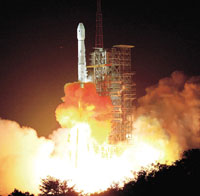我首顆直播通信衛(wèi)星“鑫諾二號(hào)”發(fā)射成功
[ 2006-10-30 16:18 ]
|
 |
|
China successfully
launched a domestically manufactured high-power communications and
broadcast satellite aboard a Long March-3B carrier rocket
Sunday.
|
China successfully launched a domestically manufactured high-power
communications and broadcast satellite aboard a Long March-3B carrier
rocket Sunday.
The new-generation SinoSat-2 satellite, launched from the Xichang
Satellite Launch Centre in Southwest China's Sichuan Province, is designed
to provide broadcast TV, digital TV, live broadcast TV and digital
broadband multimedia services to the Chinese mainland, Hong Kong, Macao
and Taiwan.
The satellite split off from the rocket about 25 minutes after its
00:20 lift-off, entering a
geosynchronous transfer orbit.
SinoSat-2, mainly developed and manufactured by the Chinese Academy of
Space Technology, weighs about 5.1 tons and has 22 transponders. It is
designed to last for 15 years, spending 12 years in orbit.
The carrier rocket used in the launch was developed and manufactured by
the Chinese Academy of Launch Vehicle Technology. The launch marked the
93rd flight for the Long March series of carrier rockets and China's 51st
consecutive successful space launch since October 1996.
A SINO Satellite Communications Co Ltd (SINOSAT) official said
SinoSat-2 will improve the capacity, safety and reliability of China's
information broadcasts and make it easier to carry out live TV broadcasts.
The original SinoSat-1 satellite, launched in July 1998, was designed
to boost China's radio and TV broadcasts and communications services in
the Asia-Pacific Region.
SinoSat-3, intended specifically for radio and TV services, is
currently being developed. It will go into operation in 2007, according to
the official.
點(diǎn)擊查看更多雙語新聞
(Agencies) |
上周日,我國自行研制的新一代大功率通信廣播衛(wèi)星“鑫諾二號(hào)”,在我國西南部的四川西昌衛(wèi)星發(fā)射中心由“長征三號(hào)乙”運(yùn)載火箭發(fā)射成功。
“鑫諾二號(hào)”通信衛(wèi)星將為我國大陸及港、澳、臺(tái)地區(qū)的廣播電視、數(shù)字電視、直播電視和數(shù)字寬帶多媒體用戶提供服務(wù)。
“鑫諾二號(hào)”衛(wèi)星于29日零時(shí)20分點(diǎn)火升空,25分鐘后與運(yùn)載火箭分離,進(jìn)入地球同步轉(zhuǎn)移軌道。
由中國空間技術(shù)研究院開發(fā)研制的“鑫諾二號(hào)”通信衛(wèi)星重約5.1噸,星上載有22個(gè)轉(zhuǎn)發(fā)器。這顆直播衛(wèi)星的設(shè)計(jì)壽命為15年,在軌服務(wù)壽命為12年。
用于發(fā)射的“長征三號(hào)乙”運(yùn)載火箭由中國運(yùn)載火箭技術(shù)研究院開發(fā)研制,本次發(fā)射是長征系列運(yùn)載火箭的第93次飛行,也是1996年10月以來我國航天發(fā)射連續(xù)第51次獲得成功。
鑫諾衛(wèi)星通信有限公司的一位負(fù)責(zé)人說,“鑫諾二號(hào)”的投入使用,將會(huì)提高我國信息廣播的能力及安全性和可靠性,對于開展電視直播業(yè)務(wù)也有重大意義。
于1998年7月發(fā)射升空的“鑫諾一號(hào)”通信衛(wèi)星主要用于推動(dòng)我國廣播電視和亞太地區(qū)通訊傳輸業(yè)務(wù)的發(fā)展。
據(jù)介紹,目前正在研制的“鑫諾三號(hào)”衛(wèi)星將專門用于廣播和電視服務(wù),計(jì)劃于明年投入使用。
(英語點(diǎn)津姍姍編輯)
|
|
|
|
Vocabulary:
lift-off : 發(fā)射升空 |
|
|
|
|
|